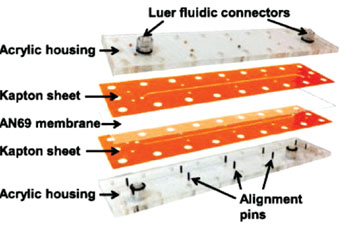Cryopreservation Significantly Extends Shelf Life of Blood
By LabMedica International staff writers
Posted on 03 Dec 2014
A method to rapidly prepare frozen red blood cells for transfusions has been reported, which may offer an important new way to manage the world's blood supply.Posted on 03 Dec 2014
While it is possible to cryopreserve human red blood cells in the presence of 40% glycerol, this is rarely done because of the time-consuming process to thaw and remove the glycerol from the blood and this can take an hour or more and makes it logistically difficult to use frozen blood.

Image: The membrane-based microfluidic device for the deglycerolization of red blood cells (Photo courtesy of Oregon State University).
Bioengineers at the Oregon State University (Corvallis, OR, USA) fabricated an appliance for the deglycerolization of red blood cells (RBC) using a microfluidic device consisting of two microchannels separated by a dialysis membrane. They used a mathematical model describing mass transfer within the device and show that the predictions are consistent with experimental measurements of solution composition and hemolysis at the device outlet.
The device consisted of a two laser-patterned Kapton sheets (DuPont, Wilmington, DE, USA), an AN69 hemodialysis membrane, and a clear acrylic housing. The device was sealed by tightening screws around the perimeter of the housing using a torque wrench to ensure even pressure distribution around the plates. Syringes filled with the desired solutions were connected to the device and 20-gauge blunt dispensing needles. The syringes were then loaded onto syringe pumps (New Era Pump Systems; Farmingdale, NY, USA) to introduce fluids into the device.
The scientists found that frozen-thawed RBCs can be flowed through a microfluidic membrane device without causing excessive mechanical damage; predictions of solution composition and cell volume are in reasonable agreement with investigational data. This opens opportunities for model-guided design of microfluidic deglycerolization processes. Using a four-stage microfluidic process, it is theoretically possible to remove glycerol in less than three minutes, more than an order of magnitude faster than current deglycerolization methods.
Adam Z. Higgins, PhD, an associate professor and coauthor of the study said, “Only a small fraction of our blood supply is now frozen, because it's often impractical to wait so long when a transfusion is needed immediately. Because of that, our entire system depends on constantly balancing the use and supply of blood products that can only last six weeks or less with refrigeration. This is difficult, and can lead to loss of outdated blood, periodic shortages, and other inefficiencies that could be solved with the use of frozen blood.” The study was published on October 28, 2014, in the journal Biomicrofluidics.
Related Links:
Oregon State University
DuPont
New Era Pump Systems













